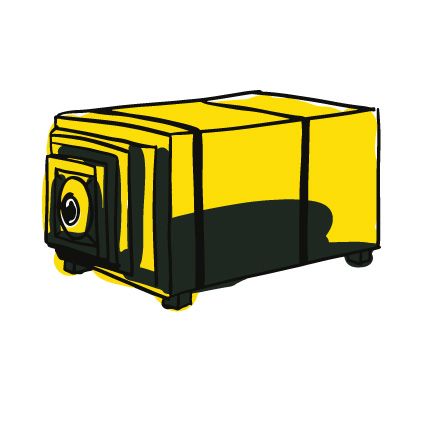
A 19. sz. közepén Franciaországban megjelenő gyerekjáték, a Polyorama panoptique tulajdonképpen egy kukucskálódoboz, mely a században igen népszerű, monumentális diorámavásznak élményét miniatűr formában nyújtotta.
A kukucskálódoboz, mint az optikai szórakoztató eszközök egyik legősibb formája, a 18. század elején jelent meg. A természet hű ábrázolása addig csak két dimenzióban jelent meg, de a tér valóságosabb ábrázolásának bemutatására igen nagy volt az igény. Ez felépítését tekintve hosszúkás, egyik oldalán kémlelőnyílással ellátott fadoboz, melybe képeket helyeztek. A lyukon benézve ismeretlen tájak, városok látványa tárult fel a néző előtt. A nagyítólencsén keresztül nézve a kép plasztikusabb lett, a néző a mélység és térbeliség illúziójában részesült, miközben a külvilág kinnrekedt.
A kukucskálódoboz olyan elbűvölő, furcsa keveréke volt a varázslatosnak és a valósnak, mely lehetővé tette a műfaj 200 éves létezését. A 19. század közepétől fokozatosan tűnt el, de kicsinyített formában, gyermekjátékként élt tovább. A Polyorama panoptique dobozában elhelyezett transzparens képek is nagyítón át szemlélhetők, s egy felső, illetve hátsó csapóajtóval a megvilágítást változtatva lehet a képben lezajló változást előidézni.
Mai digitális és vizuális zajjal körbevett világunkban elsőre talán nehezen érthető, miért volt ekkora varázsa a kukucskálódoboznak. De ha kipróbáljuk, talán mi is átélhetjük azt a titokzatos és sejtelmes élményt, mely megállásra, a pillanat átélésére késztet bennünket, és amely egy ismeretlen tájon tett képzeletbeli utazás élményével is megajándékoz bennünket.
Ludvai Zsuzsanna
restaurátor
The polyorama panoptique is a children’s toy that appeared in the 19th century in France. It is basically a peep box that provides a similar experience to the monumental diorama canvases, although on a much smaller scale.
The peep box, as one of the earliest forms of optical entertainment, appeared at the beginning of the 18th century. Until then, realistic depictions only appeared in two dimensional form, but the demand for the more accurate visualization of spaces was rather high. Structurally, this wooden box was elongated, with a peephole on one side, into which pictures were placed. Looking through the hole, a view with unfamiliar scenery or cities unfolded before the viewer's eyes. Through the magnifying glass the image became more three-dimensional, the viewer experienced an illusion of depth and space, all the while the outside world was blocked out.
The peep box was such an mesmerizing and strange mix of real and magical visuals, that it enabled the genre’s 200-year existence. From the middle of the 19th century they started to slowly disappear, but its idea lived on as smaller children’s toys. The transparent images inside the Polyorama panoptique are viewed through a magnifying glass, with hatches located on the top and back of the box that alter the lighting. Changing the lighting inside the box, made it possible for the viewer to bring forth the changes in the image.
In today’s world, filled with digital noise, it might be difficult to understand the magical experience of the peep box. But if we try it ourselves, maybe we can live through the mysterious and mystical experience too, which might make us pause and experience an imaginary journey through unknown lands.
Zsuzsanna Ludvai
restorer